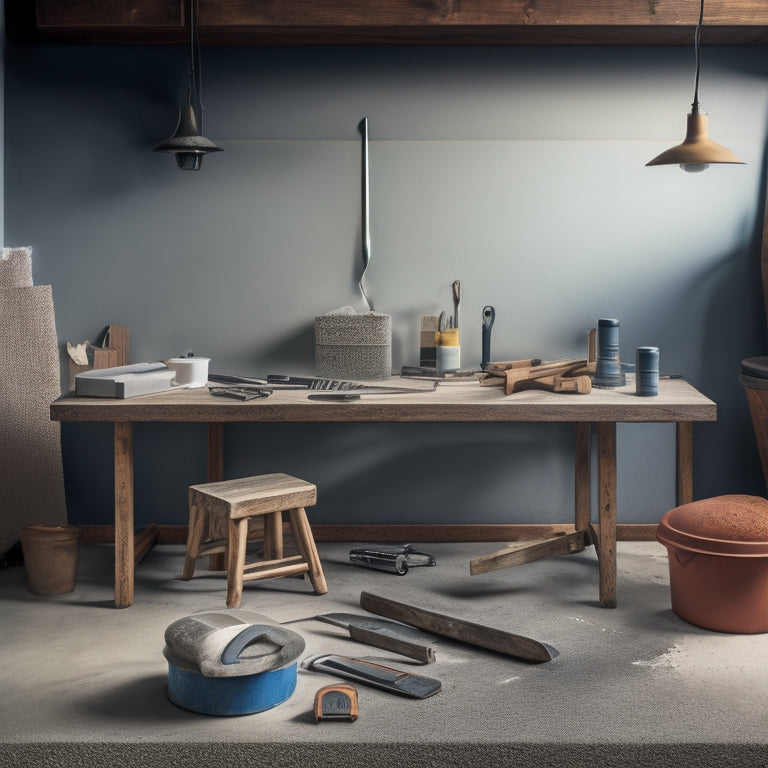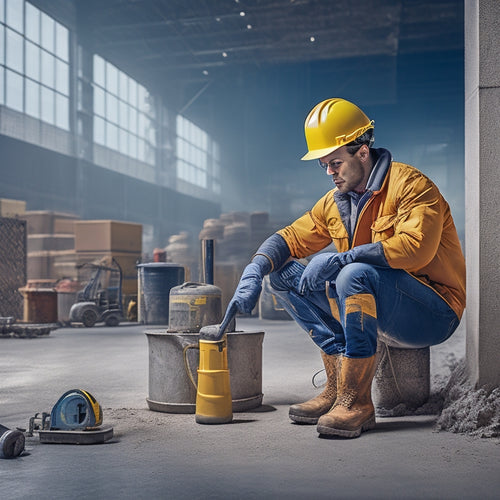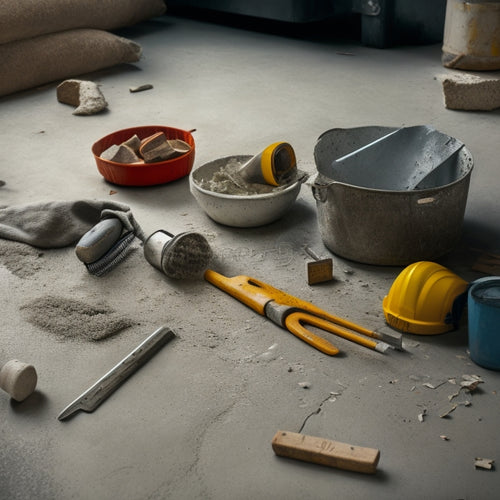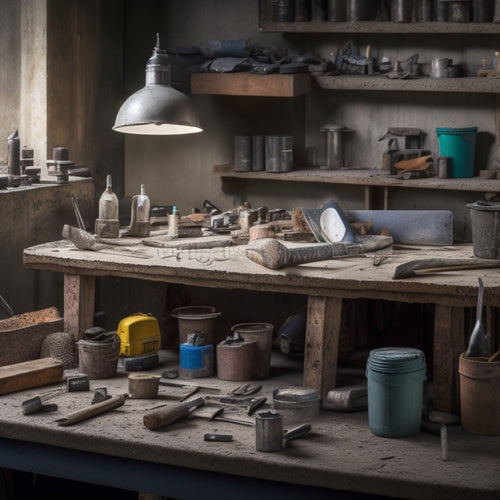
10 Best Hand Tools for Fast Concrete Laying
Share
When it comes to fast and professional-looking concrete laying, having the right hand tools is essential. You'll need high-quality trowels for smooth finishes, precision jointers for clean cuts, and accurate levels for perfect alignment. Heavy-duty hammers, efficient edgers, and precise chisels will help you tackle tough jobs with ease. Additionally, reliable straightedges, sturdy rakes, and versatile scrapers will guarantee your surfaces are level and debris-free. With these must-have tools in your arsenal, you'll be well on your way to achieving fast and flawless concrete laying results - and that's just the starting point for mastering the art of concrete laying.
Key Takeaways
• Master trowel techniques, including long sweeping strokes and finishing strokes, for a professional-looking concrete finish.
• Invest in high-quality jointers with precision-machined tables and high-torque motors for flawless surface finishes.
• Choose durable surface finishing tools like magnesium or steel floats with even-grit surfaces for consistent finishes.
• Reliable levels, such as laser levels, and digital angle measurement tools are essential for achieving precise measurements.
• Select heavy-duty hammers with substantial weight and balance, and durable materials like high-quality steel or titanium for effective impact.
Essential Trowels for Smooth Finishes
You'll need a high-quality trowel to achieve a smooth, even finish when laying concrete, as it allows for precise control over the material and helps to eliminate air pockets and imperfections. With the right trowel, you'll be able to master various trowel techniques, such as floating, finishing, and edging, to produce a professional-looking finish.
When selecting a trowel, consider the type of concrete you're working with, as well as the desired finish. For example, a steel trowel is ideal for high-strength concrete, while a resin trowel is better suited for decorative finishes.
To achieve a smooth finish, use long, sweeping strokes to spread the concrete, holding the trowel at a 45-degree angle. As you work, use a level to guarantee the surface is even.
For a more polished finish, switch to a finishing trowel and use shorter, overlapping strokes. By mastering these trowel techniques and finishing methods, you'll be able to produce high-quality concrete finishes that meet your project's requirements.
High-Quality Jointers for Precision
When selecting a jointer for concrete laying, you'll want to prioritize precision edge control to guarantee straight, clean cuts.
A high-quality jointer should also provide a smooth surface finish, free from imperfections and irregularities.
Additionally, an adjustable fence system will give you the flexibility to customize your cuts and achieve the exact results you need.
Precise Edge Control
Achieving precise edge control is critical in concrete laying, and high-quality jointers are vital tools for guaranteeing accurate and consistent joint formation. As you work on a concrete project, you need to ascertain that the edges of the concrete slabs align perfectly to achieve a strong and durable structure. High-quality jointers help you accomplish this by providing precise edge alignment, which is critical for the overall integrity of the concrete structure.
To get the most out of your jointer, it is important to perform regular tool maintenance. This includes cleaning the jointer regularly, checking for wear and tear, and replacing worn-out parts.
Here's a comparison of different jointer features to evaluate:
| Feature | Description |
|---|---|
| Cutting Width | The width of the jointer's cutting edge, affecting the speed of joint formation |
| Depth Adjustment | The ability to adjust the jointer's cutting depth for precise control |
| Fence System | A system that helps maintain edge alignment and prevents deviations |
| Motor Power | The power of the jointer's motor, affecting its ability to handle tough concrete |
Smooth Surface Finish
By employing high-quality jointers that provide a smooth surface finish, concrete layers can assure that their projects meet the highest standards of quality and aesthetics.
You'll be able to achieve a flawless finish that's free of imperfections, which is critical in concrete laying. High-quality jointers are designed to utilize advanced smoothing techniques that guarantee a uniform surface, making them an essential tool in your arsenal.
When it comes to surface preparation, a jointer's precision is unmatched, allowing you to remove minor imperfections and create a smooth, even base for your concrete pour.
When selecting a jointer, look for models that feature precision-machined tables and fences, as well as high-torque motors that can handle demanding tasks.
Additionally, consider jointers with adjustable cutting depths, which enable you to tailor your smoothing process to specific project requirements.
By incorporating a high-quality jointer into your workflow, you'll be able to produce concrete surfaces that are both visually stunning and technically sound.
With the right jointer, you'll be able to take your concrete laying skills to the next level and deliver exceptional results that exceed client expectations.
Adjustable Fence System
Operating a high-quality jointer with an adjustable fence system enables you to make precise adjustments, guaranteeing that your concrete surfaces meet the exacting standards of your clients and your own high expectations. This feature is particularly useful when working with large or complex concrete projects, where even minor deviations can have significant consequences.
| Adjustable Fence Benefits | Description |
|---|---|
| Improved Accuracy | Allows for precise adjustments to guarantee accurate cuts and joints |
| Increased Efficiency | Enables you to work faster and more efficiently, reducing project timelines |
| Enhanced Versatility | Accommodates a wide range of concrete sizes and shapes |
| Easy Installation | Simplifies the adjustable fence installation process, saving you time and effort |
Best Levels for Accurate Alignment
When you're working on a concrete laying project, you know that accurate alignment is essential.
To achieve this, you'll need a reliable level that provides precise measurements, and that's where laser level precision comes in.
You'll want to take into account levels that offer digital angle measurement and a vial accuracy check to guarantee your work is spot on.
Laser Level Precision
You'll achieve precise alignment and accurate leveling with a high-quality laser level, an essential tool for guaranteeing your concrete laying project meets exacting standards. A reliable laser level guarantees that your concrete slab is perfectly level, which is vital for structural integrity and aesthetic appeal.
To get the most out of your laser level, it's important to perform regular laser calibration techniques to maintain accuracy. This involves checking and adjusting the level's settings to make sure it's providing precise readings. Additionally, leveling tool maintenance is essential to prevent damage and extend the tool's lifespan.
Here are some key considerations when selecting a laser level for your concrete laying project:
| Feature | Description | Importance |
|---|---|---|
| Accuracy | ±1/16 inch at 100 ft | High |
| Range | Up to 1,000 ft | Medium |
| Durability | Water and dust resistance | High |
Digital Angle Measurement
As you make certain your concrete slab is perfectly level with a reliable laser level, precise angle measurement becomes the next significant step in achieving accurate alignment. That's where digital angle measurement tools come into play. These tools guarantee you're working with precise angles, which is vital for a successful concrete lay.
Here are some excellent digital angle measurement tools to take into account:
-
Digital Inclinometers: These tools measure angles with high accuracy, often up to 0.1 degrees. They're ideal for measuring complex angles, such as those found in stairs, ramps, or inclined surfaces.
-
Angle Finders: These handheld tools use a combination of sensors and algorithms to provide accurate angle measurements. They're perfect for quick checks and spot measurements.
-
Digital Protractors: These tools offer precise angle measurements, often with a high-resolution display. They're great for measuring angles between two surfaces or for checking the accuracy of other angle measurement tools.
- Smart Angle Sensors: These sensors connect to your smartphone or tablet, allowing you to measure and record angles with ease. They're ideal for large-scale projects or when you need to track angle measurements over time.
Vial Accuracy Check
To guarantee accurate alignment, it's vital to perform a vial accuracy check on your levels, which involves verifying that the level's vial is correctly calibrated and aligned with the tool's frame.
You'll want to confirm the vial is free from air bubbles, contaminants, or other obstructions that could affect its accuracy. Start by holding the level perfectly level and checking the vial for any deviation from the center. If you notice any issues, it's time to recalibrate your level using established vial calibration techniques.
Regular vial maintenance tips include storing your levels in a protective case, avoiding extreme temperatures, and cleaning the vial regularly with a soft cloth and mild soap solution.
You should also check your level's vial for scratches or cracks, which can compromise its accuracy. By performing routine vial accuracy checks and following these maintenance tips, you can trust that your levels will provide precise readings, allowing for accurate alignment and superior concrete laying results.
Heavy-Duty Hammers for Tough Jobs
Tackling demanding concrete laying tasks requires a heavy-duty hammer that can withstand the rigors of intense impact and vibration. You need a reliable tool that can deliver powerful blows without compromising its durability. When working on heavy-duty construction projects, a sturdy hammer is essential for breaking up concrete, driving stakes, and demolishing structures.
Here are the key features to look for in a heavy-duty hammer:
-
Weight and balance: A well-balanced hammer with a substantial weight (typically 16-24 oz) provides the necessary force for tough jobs.
-
Durable materials: Look for hammers made from high-quality steel, fiberglass, or titanium that can withstand heavy use.
-
Ergonomic design: A comfortable grip and contoured handle reduce fatigue and improve control.
- Shock-absorbing technology: Features like shock-absorbing handles or cushions help reduce vibration and minimize fatigue.
As a demolition tool, your heavy-duty hammer should be able to withstand the toughest conditions. By investing in a high-quality hammer, you'll be able to tackle even the most demanding concrete laying tasks with confidence.
Efficient Edgers for Crisp Cuts
You'll need an efficient edger that can deliver crisp, clean cuts to achieve professional-looking results in concrete laying projects.
When selecting an edger, consider hand tool materials that can withstand the rigors of concrete work. Look for edgers with high-carbon steel blades or durable carbide-tipped edges that can maintain their sharpness over time.
A well-maintained edge is essential for making precise cuts, so edge maintenance is key. Regularly inspect and clean your edger to prevent rust and corrosion. Additionally, keep the edger's pivot points well-lubricated to guarantee smooth operation.
A high-quality edger will allow you to make accurate cuts with minimal effort, saving you time and energy. With the right edger in your toolkit, you'll be able to achieve crisp, clean cuts that set your concrete work apart from the rest.
Durable Floats for Perfect Finishing
Durable floats with dense, even-grit surfaces are essential for achieving a smooth, blemish-free finish in concrete laying projects. You'll want to choose floats made from high-quality materials that can withstand the rigors of concrete finishing. Look for floats with durable handles and comfortable grips to reduce fatigue during extended use.
When selecting the right float for your project, consider the following factors:
-
Float materials: Choose floats made from durable materials like magnesium, aluminum, or steel. These materials provide the necessary weight and strength for effective finishing.
-
Float sizes: Select floats in a range of sizes to accommodate different areas of your project. Common sizes include 12', 18', and 24'.
-
Grit surface: Opt for floats with even-grit surfaces, which provide a consistent finish and prevent scratching the concrete.
- Handle type: Consider floats with ergonomic handles or adjustable handles to fit your grip and reduce strain.
Precise Chisels for Block Shaping
Shaping concrete blocks to precise dimensions requires chisels that can accurately remove material without causing damage or crumbling. You need chisels that can withstand the rigors of concrete block shaping while maintaining their edge and precision.
When selecting a chisel for block shaping, look for ones made from high-carbon steel or tungsten carbide, which offer superior durability and resistance to wear.
To get the most out of your chisels, it's crucial to practice effective chisel maintenance techniques. Regularly clean and sharpen your chisels to prevent rust and maintain their cutting edge. Store them in a dry place, away from other tools, to prevent damage.
When it comes to block shaping strategies, you'll want to use a combination of strikes and gentle tapping to remove material. Start with a coarse chisel to rough out the shape, then switch to a finer chisel for more precise work.
Reliable Straightedges for Guidance
Your concrete laying project demands accurate alignment, and a reliable straightedge is essential for guiding your tools and ensuring precise cuts. A high-quality straightedge helps you maintain consistent alignment, ensuring your concrete slabs are even and professional-looking.
When selecting a straightedge, consider the following factors:
-
Materials: Look for straightedges made from durable materials like aluminum, stainless steel, or fiberglass, which can withstand heavy use and harsh construction environments.
-
Length and width: Choose a straightedge that's long enough to span your concrete sections, with a width that accommodates your tools and allows for easy handling.
-
Accuracy: Opt for a straightedge with precision-engineered edges, ensuring accurate alignment and minimizing errors.
- Ergonomics: Select a straightedge with comfortable grips and a balanced design, reducing fatigue and improving control during extended use.
Sturdy Rakes for Leveling Surfaces
To achieve a smooth, even finish, you'll need a sturdy rake that can efficiently level and compact your concrete surfaces, especially in areas with significant aggregate exposure. A good rake should have an ergonomic design that reduces fatigue and allows you to work efficiently for extended periods. Look for rakes with durable materials, such as high-carbon steel or fiberglass, that can withstand the rigors of concrete work.
Here are some key features to take into account when selecting a sturdy rake for leveling surfaces:
| Feature | Description |
|---|---|
| Head Width | 12-18 inches for efficient coverage |
| Tine Material | High-carbon steel or fiberglass for durability |
| Handle Material | Ergonomic grip with durable materials (e.g., fiberglass or wood) |
| Weight | Lightweight design for reduced fatigue |
When choosing a rake, reflect on the specific demands of your project and select a tool that meets those needs. With the right rake, you'll be able to achieve a smooth, even finish and guarantee a strong, durable concrete surface.
Versatile Scrapers for Debris Removal
Efficient debris removal is essential for a successful concrete laying process, and that's where versatile scrapers come into play. They help you clear the area of unwanted materials and prepare the surface for a strong bond. As you work on your concrete project, you'll encounter various types of debris, from dirt and rocks to old adhesive and broken concrete. To tackle these effectively, you need a scraper that can adapt to different situations.
Here are some key considerations for choosing the right scraper for your debris management techniques:
-
Material options: Look for scrapers made from durable materials like stainless steel, aluminum, or high-carbon steel, which can withstand heavy use and harsh environments.
-
Blade type: Select a scraper with a blade type that suits your specific needs, such as a flat blade for general-purpose scraping or a curved blade for removing old adhesive.
-
Handle comfort: Opt for a scraper with a comfortable, ergonomic handle that reduces fatigue and provides better control.
- Adjustability: Consider a scraper with an adjustable blade angle or handle length to customize the tool to your preferences.
Frequently Asked Questions
What Safety Gear Is Necessary for Concrete Laying?
When working with concrete, you'll need to prioritize your safety above all else.
You're exposed to hazardous materials, heavy objects, and physical strain, so it's crucial to wear the right safety gear.
Invest in protective equipment like steel-toed boots, gloves, safety glasses, and a dust mask.
Don't forget a hard hat and a high-visibility vest to minimize risks.
How Often Should I Clean My Hand Tools?
Like a well-oiled machine, your hand tools require regular tune-ups to perform at their best.
When it comes to tool maintenance, cleaning frequency is key. You should clean your hand tools after every use, wiping down metal surfaces with a dry cloth to prevent rust and corrosion.
For more thorough cleaning, set aside time each week to scrub away dirt and grime with soap and water.
Can I Use Hand Tools for Large Commercial Projects?
When tackling large commercial projects, you'll need to assess whether hand tools can keep up with the demands.
While they offer excellent hand tool efficiency for smaller tasks, commercial project limitations come into play when scaling up.
You'll encounter bottlenecks in productivity, and the manual labor required will hinder your ability to meet tight deadlines.
It's crucial to weigh the benefits of hand tools against the project's scope and timeline to determine if they're the right fit.
What Is the Best Way to Store Hand Tools on Site?
Are you tired of wasting valuable time searching for misplaced tools on site? You need a solid tool organization strategy.
Invest in portable storage solutions like tool chests, boxes, or bags with designated compartments. Label each section clearly, and assign a specific place for each tool.
This way, you'll always know exactly where to find what you need, and your workflow will become more efficient.
Are Hand Tools Suitable for Laying Concrete in Cold Weather?
When you're working with concrete in cold weather, you're right to wonder if your hand tools are up to the task.
The truth is, cold temperatures can greatly impact hand tool performance.
To overcome this, you'll need to employ cold weather techniques, such as using insulated tools, working in shorter intervals, and maintaining tool temperature.
Conclusion
You've got the foundation of a concrete laying arsenal at your fingertips.
With these superior hand tools, you'll be well on your way to crafting surfaces that exude precision, finesse, and a touch of artistry.
As you wield these trusted companions, you'll transform raw concrete into a masterpiece, born from the symphony of sweat, skill, and attention to detail.
Your work will stand as proof of the beauty of precision, where every stroke, every cut, and every finish speaks to your unwavering dedication to the craft.
Related Posts
-

10 Best Tools for Sealed Concrete Flooring on Budget
When starting on a sealed concrete flooring project on a budget, you'll need to prioritize essential tools without sa...
-

Top 10 Concrete Repair Tools for Small Fixes
You'll need the right tools to tackle small concrete repairs efficiently and effectively. When it comes to small fixe...
-

Top Tools for Concrete Repair Success
When it comes to concrete repair success, you'll need a well-stocked toolkit with essential hand tools like trowels, ...


